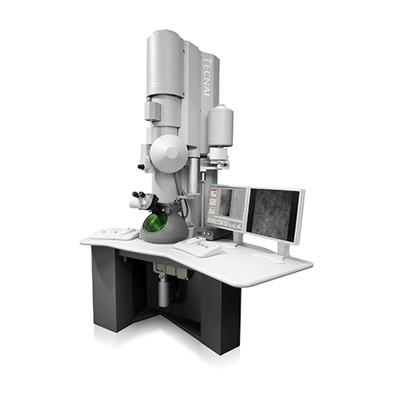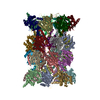+ Open data
Open data
- Basic information
Basic information
| Entry | Database: EMDB / ID: EMD-5613 | |||||||||
|---|---|---|---|---|---|---|---|---|---|---|
| Title | Yeast 20S proteasome with C-terminal peptide of yeast Rpt3 | |||||||||
 Map data Map data | 3D density map of yeast 20S proteasome core particle with GST tag added to the C-terminus of beta-2 subunit in complex with the C-terminal peptide of yeast Rpt3 | |||||||||
 Sample Sample |
| |||||||||
 Keywords Keywords | Yeast 20S proteasome / C-terminal peptide / yeast Rpt3 | |||||||||
| Biological species |  | |||||||||
| Method | single particle reconstruction / cryo EM / Resolution: 7.7 Å | |||||||||
 Authors Authors | Li X / Kim HM / Cheng Y | |||||||||
 Citation Citation |  Journal: Nature / Year: 2013 Journal: Nature / Year: 2013Title: Reconfiguration of the proteasome during chaperone-mediated assembly. Authors: Soyeon Park / Xueming Li / Ho Min Kim / Chingakham Ranjit Singh / Geng Tian / Martin A Hoyt / Scott Lovell / Kevin P Battaile / Michal Zolkiewski / Philip Coffino / Jeroen Roelofs / Yifan ...Authors: Soyeon Park / Xueming Li / Ho Min Kim / Chingakham Ranjit Singh / Geng Tian / Martin A Hoyt / Scott Lovell / Kevin P Battaile / Michal Zolkiewski / Philip Coffino / Jeroen Roelofs / Yifan Cheng / Daniel Finley /  Abstract: The proteasomal ATPase ring, comprising Rpt1-Rpt6, associates with the heptameric α-ring of the proteasome core particle (CP) in the mature proteasome, with the Rpt carboxy-terminal tails inserting ...The proteasomal ATPase ring, comprising Rpt1-Rpt6, associates with the heptameric α-ring of the proteasome core particle (CP) in the mature proteasome, with the Rpt carboxy-terminal tails inserting into pockets of the α-ring. Rpt ring assembly is mediated by four chaperones, each binding a distinct Rpt subunit. Here we report that the base subassembly of the Saccharomyces cerevisiae proteasome, which includes the Rpt ring, forms a high-affinity complex with the CP. This complex is subject to active dissociation by the chaperones Hsm3, Nas6 and Rpn14. Chaperone-mediated dissociation was abrogated by a non-hydrolysable ATP analogue, indicating that chaperone action is coupled to nucleotide hydrolysis by the Rpt ring. Unexpectedly, synthetic Rpt tail peptides bound α-pockets with poor specificity, except for Rpt6, which uniquely bound the α2/α3-pocket. Although the Rpt6 tail is not visualized within an α-pocket in mature proteasomes, it inserts into the α2/α3-pocket in the base-CP complex and is important for complex formation. Thus, the Rpt-CP interface is reconfigured when the lid complex joins the nascent proteasome to form the mature holoenzyme. | |||||||||
| History |
|
- Structure visualization
Structure visualization
| Movie |
 Movie viewer Movie viewer |
|---|---|
| Structure viewer | EM map:  SurfView SurfView Molmil Molmil Jmol/JSmol Jmol/JSmol |
| Supplemental images |
- Downloads & links
Downloads & links
-EMDB archive
| Map data |  emd_5613.map.gz emd_5613.map.gz | 25.6 MB |  EMDB map data format EMDB map data format | |
|---|---|---|---|---|
| Header (meta data) |  emd-5613-v30.xml emd-5613-v30.xml emd-5613.xml emd-5613.xml | 9.4 KB 9.4 KB | Display Display |  EMDB header EMDB header |
| Images |  emd_5613_1.jpg emd_5613_1.jpg | 117.4 KB | ||
| Archive directory |  http://ftp.pdbj.org/pub/emdb/structures/EMD-5613 http://ftp.pdbj.org/pub/emdb/structures/EMD-5613 ftp://ftp.pdbj.org/pub/emdb/structures/EMD-5613 ftp://ftp.pdbj.org/pub/emdb/structures/EMD-5613 | HTTPS FTP |
-Validation report
| Summary document |  emd_5613_validation.pdf.gz emd_5613_validation.pdf.gz | 78.6 KB | Display |  EMDB validaton report EMDB validaton report |
|---|---|---|---|---|
| Full document |  emd_5613_full_validation.pdf.gz emd_5613_full_validation.pdf.gz | 77.7 KB | Display | |
| Data in XML |  emd_5613_validation.xml.gz emd_5613_validation.xml.gz | 493 B | Display | |
| Arichive directory |  https://ftp.pdbj.org/pub/emdb/validation_reports/EMD-5613 https://ftp.pdbj.org/pub/emdb/validation_reports/EMD-5613 ftp://ftp.pdbj.org/pub/emdb/validation_reports/EMD-5613 ftp://ftp.pdbj.org/pub/emdb/validation_reports/EMD-5613 | HTTPS FTP |
-Related structure data
| Related structure data |  5593C  5611C  5612C  5614C  5615C  5616C  5617C  4jpoC C: citing same article ( |
|---|---|
| Similar structure data |
- Links
Links
| EMDB pages |  EMDB (EBI/PDBe) / EMDB (EBI/PDBe) /  EMDataResource EMDataResource |
|---|
- Map
Map
| File |  Download / File: emd_5613.map.gz / Format: CCP4 / Size: 29.8 MB / Type: IMAGE STORED AS FLOATING POINT NUMBER (4 BYTES) Download / File: emd_5613.map.gz / Format: CCP4 / Size: 29.8 MB / Type: IMAGE STORED AS FLOATING POINT NUMBER (4 BYTES) | ||||||||||||||||||||||||||||||||||||||||||||||||||||||||||||||||||||
|---|---|---|---|---|---|---|---|---|---|---|---|---|---|---|---|---|---|---|---|---|---|---|---|---|---|---|---|---|---|---|---|---|---|---|---|---|---|---|---|---|---|---|---|---|---|---|---|---|---|---|---|---|---|---|---|---|---|---|---|---|---|---|---|---|---|---|---|---|---|
| Annotation | 3D density map of yeast 20S proteasome core particle with GST tag added to the C-terminus of beta-2 subunit in complex with the C-terminal peptide of yeast Rpt3 | ||||||||||||||||||||||||||||||||||||||||||||||||||||||||||||||||||||
| Projections & slices | Image control
Images are generated by Spider. | ||||||||||||||||||||||||||||||||||||||||||||||||||||||||||||||||||||
| Voxel size | X=Y=Z: 1.47 Å | ||||||||||||||||||||||||||||||||||||||||||||||||||||||||||||||||||||
| Density |
| ||||||||||||||||||||||||||||||||||||||||||||||||||||||||||||||||||||
| Symmetry | Space group: 1 | ||||||||||||||||||||||||||||||||||||||||||||||||||||||||||||||||||||
| Details | EMDB XML:
CCP4 map header:
| ||||||||||||||||||||||||||||||||||||||||||||||||||||||||||||||||||||
-Supplemental data
- Sample components
Sample components
-Entire : Yeast 20S proteasome
| Entire | Name: Yeast 20S proteasome |
|---|---|
| Components |
|
-Supramolecule #1000: Yeast 20S proteasome
| Supramolecule | Name: Yeast 20S proteasome / type: sample / ID: 1000 / Oligomeric state: 28mer / Number unique components: 1 |
|---|---|
| Molecular weight | Experimental: 700 KDa |
-Macromolecule #1: 20S proteasome
| Macromolecule | Name: 20S proteasome / type: protein_or_peptide / ID: 1 / Details: GST tag was added to C-terminus of beta-2 subunit / Recombinant expression: No / Database: NCBI |
|---|---|
| Source (natural) | Organism:  |
| Molecular weight | Experimental: 700 KDa |
-Experimental details
-Structure determination
| Method | cryo EM |
|---|---|
 Processing Processing | single particle reconstruction |
| Aggregation state | particle |
- Sample preparation
Sample preparation
| Grid | Details: Quantifoil grid |
|---|---|
| Vitrification | Cryogen name: ETHANE / Chamber humidity: 100 % / Chamber temperature: 120 K / Instrument: FEI VITROBOT MARK III |
- Electron microscopy
Electron microscopy
| Microscope | FEI TECNAI F20 |
|---|---|
| Details | Low-Dose procedure |
| Date | Jan 1, 2010 |
| Image recording | Category: CCD / Film or detector model: TVIPS TEMCAM-F816 (8k x 8k) / Average electron dose: 25 e/Å2 |
| Tilt angle min | 0 |
| Tilt angle max | 0 |
| Electron beam | Acceleration voltage: 200 kV / Electron source:  FIELD EMISSION GUN FIELD EMISSION GUN |
| Electron optics | Illumination mode: FLOOD BEAM / Imaging mode: BRIGHT FIELD / Cs: 2.0 mm / Nominal defocus max: 2.1 µm / Nominal defocus min: 1.2 µm / Nominal magnification: 100000 |
| Sample stage | Specimen holder: CT3500 / Specimen holder model: GATAN LIQUID NITROGEN |
| Experimental equipment |  Model: Tecnai F20 / Image courtesy: FEI Company |
- Image processing
Image processing
| Details | FREALIGN |
|---|---|
| CTF correction | Details: Each particle |
| Final reconstruction | Resolution.type: BY AUTHOR / Resolution: 7.7 Å / Resolution method: FSC 0.143 CUT-OFF / Software - Name: FREALIGN / Number images used: 74177 |
-Atomic model buiding 1
| Initial model | PDB ID: |
|---|---|
| Software | Name:  Chimera Chimera |
| Refinement | Space: REAL / Protocol: RIGID BODY FIT |
 Movie
Movie Controller
Controller









 Z (Sec.)
Z (Sec.) Y (Row.)
Y (Row.) X (Col.)
X (Col.)






















